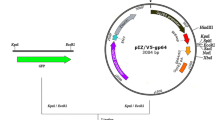Abstract
Rice stripe virus (RSV) infects rice and is transmitted in a propagative manner by the small brown planthopper. How RSV enters an insect cell to initiate the infection cycle is poorly understood. Sequence analysis revealed that the RSV NSvc2 protein was similar to the membrane glycoproteins of several members in the family Bunyaviridae and might induce cell membrane fusion. To conveniently study the membrane fusion activity of NSvc2, we constructed cell surface display vectors for expressing Nsvc2 on the insect cell surface as the membrane glycoproteins of the enveloped viruses. Our results showed that NSvc2 was successfully expressed and displayed on the surface of insect Sf9 cells. When induced by low pH, the membrane fusion was not observed in the cells that expressed NSvc2. Additionally, the membrane fusion was also not detected when co-expressing Nsvc2 and the viral capsid protein on insect cell surface. Thus, RSV NSvc2 is probably different from the phlebovirus counterparts, which could suggest different functions. RSV might enter insect cells other than by fusion with plasma or endosome membrane.
Similar content being viewed by others
References
Chapple S D, Jones I M. 2002. Non-polar distribution of green fluorescent protein on the surface of Autographa californica nucleopolyhedrovirus using a heterologous membrane anchor. J Biotech, 95:269–275.
Cortez I, Aires A, Pereira A M, et al. 2002. Genetic organization of Iris yellow spot virus M RNA: indications for functional homology between the Gc glycoproteins of tospoviruses and anomal-infecting bunyaviruses. Arch Virol, 147(2):2313–2325.
Elizabeth M E, Suyenaga K, Tsai J H, et al. 1996. Maize stripe tenuivirus RNA2 transcripts in plant and insect hosts and analysis of Pvc2, a protein similar to the phlebvirus virion membrane glycoproteins. Virus Genes, 12(3):239–247.
Falk B W, Tsai J H. 1998. Biology and molecular biology of viruses in the genus tenuivirus. Annu Rev Phytopathol, 36:139–163.
Filone C M, Heise M, Doms R W, et al. 2006. Development and characterization of a Rift Valley fever virus cell-cell fusion assay using alphavirus replicon vectors. Virology, 356:155–164.
Fordan M, Wirblich C, Roy P. 2003. A capsid protein of nonenveloped bluetongue virus exhibits membrane fusion activity. Proc Natl Acad Sci USA, 101(7):2100–2105.
Garry C E, Garry R F. 2004. Proteomics computational analyses suggest that the carboxyl terminal glycoproteins of Bunyaviruses are class II viral fusion protein (beta-penetrenes). Theor Biol Med Model, 1:10.
Hernandez L D, Hoffman L R, Wolfsberg T G, et al. 1996. Virus-cell and cell-cell fusion. Annu Rev Cell Dev Biol, 12:627–661.
Kakutani T, Hayano Y, Hayashi T, et al. 1990. Ambisense segment 4 of rice stripe virus: possible evolutionary relationship with phleboviruses and uukuviruses. J Gen Virol, 71:1427–1432.
Kakutani T, Hayano Y, Hayashi T, et al. 1991. Ambisense segment 3 of rice stripe virus: the first instance of a virus containing two ambisense segments. J Gen Virol, 72:465–468.
Kalia M, Jameel S. 2011. Virus entry paradigms. Amino Acids, 41(5):1147–1157.
Liang D L, Qu Z C, Ma X Q, et al. 2005. Detection and localization of rice stripe virus gene products in vivo. Virus Genes, 31(2):211–221.
Ogino M, Yoshimatsu K, Ebihara H, et al. 2004. Cell fusion activities of Hantaan virus envelope glycoproteins. J Virol, 78:10776–10782.
Plassmeyer M L, Soldan S S, Stachelek K M, et al. 2005. California serogroup Gc (G1) glycoprotein is the principal determinant of pH-dependent cell fusion and entry. Virology, 338: 121–132.
Shi X H, Goli G, Clark G, et al. 2009. Functional analysis of the Bunyamwera orthobunyavirus Gc glycoprotein. J Gen Virol, 90:2483–2492.
Shi X H, Kohl A, Li P, Elliott R M. 2007. Role of the cytoplasmic tail domains of Bunyamwera orthobunyavirus glycoproteins Gn and Gc in virus assembly and morphogenesis. J Virol, 81(8):10151–10160.
Takahashi M, Toriyama S, Hamamatsu C, et al. 1993. Nucleotide sequence and possible ambisence coding strategy of rice stripe virus segment 2. J Gen Virol, 74:769–773.
Toriyama S, Takahashi M, Sano Y, et al. 1994. Nucleotide sequence of RNA1, the largest genomic segment of rice stripe virus, the prototype of the tenuiviruses. J Gen Virol, 75: 3569–3579.
Whitfield A E, Ullman D E, German T L. 2005. Tomato spotted wilt virus glycoprotein GC is cleaved at acidic pH. Virus Res, 110:183–186.
Xiong R Y, Wu J X, Zhou Y J, et al. 2008. Identification of a movement protein of the tenuivirus rice stripe virus. J Virol, 82(24):12304–12311.
Xiong R Y, Wu J X, Zhou Y J, et al. 2009. Characterization and subcellular localization of an RNA silencing suppressor encoded by Rice stripe tenuivirus. Virology, 387:29–40.
Zhou F, Pu Y Y, Wei T Y, et al. 2007. The P2 capsid protein of the nonenveloped rice dwarf phytoreovirus induces membrane fusion in insect host cells. Proc Natl Acad Sci USA, 104(49): 19547–19552.
Author information
Authors and Affiliations
Corresponding authors
Additional information
Foundation items: Natural Science Foundation of China Grants (30970138) and the Priority Academic Program Development of Jiangsu Higher Education Institutions.
Rights and permissions
About this article
Cite this article
Zhao, Sl., Dai, Xj., Liang, Js. et al. Surface display of rice stripe virus NSvc2 and analysis of its membrane fusion activity. Virol. Sin. 27, 100–108 (2012). https://doi.org/10.1007/s12250-012-3237-x
Received:
Accepted:
Published:
Issue Date:
DOI: https://doi.org/10.1007/s12250-012-3237-x




